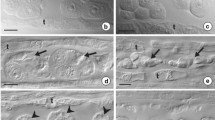Abstract
Anatomical changes occurring during the microsporogenic development of P. salicina Lindl. were studied in male fertile and male sterile genotypes. Male fertile pollen grains showed three well determined pore regions, without ektexine. Intine was thick and surrounded the vegetative cell. Vegetative cells enclosed the generative cells; their cytoplasm was rich in plastids, abundant RER and active mitochondria. Development of sterile pollen was different from the meiosis step. Microspores did not show germination pores and ektexine was continuous around the whole grain. Pollen grains showed an atypical shape. The tapetum persisted after the tetrad stage and showed hypertrophy and vacuole development, resulting in abnormal microspore development. Only a few pollen grains and rudiments of collapsed microspores close to the anther wall were formed at anthesis.






Similar content being viewed by others
References
Bellini E, Nencetti V (1998) Japanese plum breeding programme at Florence: first results. Acta Hortic 478:147–50
Bellini E, Nencetti V, Nin S (2002) Genetic improvement of plum in Florence. Acta Hortic 577:19–24
Bhadula SK, Sawhney VK (1987) Esterase activity and isozymes during the ontogeny of stamens of male fertile Lycopersicon esculentum Mill. and stamenless-2 mutant and the low temperature reverted mutant. Pl Sci 52:187–194
Bubán T (1996) Flower development and formation of sexual organs. In: Nyéki J, Soltész M (eds) Floral biology of temperate zone fruit trees and small fruits. Akadémiai Kiadó, Budapest, pp 3–54
Cutter EG (1971) Plant anatomy: experiment and interpretation part 2. Organs. E. Arnold, London, pp 343
Fleckinger J (1955) Phenologie et arboriculture frutière. Bon Jardinier 1:362–372
Heslop-Harrison J (1972) Sexuality of angiosperms. In: Steward FC (ed) Plant physiology: a treatise, vol. 6C. Academic Press, New York, pp 134–289
Medeira MC, Guêdes ME (1991) Flower bud abscission and male sterility in apricot. Acta Hortic 293:311–318
Ontivero MR, Radice S, Giordani E, Bellini E (2005) Preliminary studies on microsporogenesis of Prunus salicina Lindl. J Hortic Sci Biotechnol 80:599–604
Oukabli A, Lansari A, Wallali LDE, Abousalim A (2000) Inbreeding consequences related to self-compatibility in almond. NUCIS Newsl 9:9–12
Padula G, Bellini E, Radice S, Giordani E, Nencetti V (2004) Fertilità in susino cino-giapponese (Prunus salicina Lindl.): prime indagini morfologiche e fisiologiche su polline. Italus Hortus 2:52–53
Peng WX, Yang JM, Zhang Q, Meng QR, Li SH, Sun FZ, Zhao TC (2001) Effect of ice nucleation active bacteria on the ultrastructure of the pollen of an apricot variety. Acta Hortic Sin 28(5):453–456
Radice S (2005) Biología floral y éxito reproductivo del cultivar Forastero [Prunus persica (L.) Batsch] Rosaceae, Prunoideae, en estiones crecidos sobre pies francos o clonales macro y micropropagados. Dissertation (Unpublished), Buenos Aires University
Schwalm S, Hartmann W, Stösser R (1995a) Pollenentwicklung bei männlich fertilen und sterilen Sorten bei Pflaumen und Zwetschen (Prunus domestica L. ssp. domestica). Gartenbauwissenschaft 60(4):145–150
Schwalm S, Hartmann W, Stösser R (1995b) Pollenentwicklung bei der männlich sterilen Zwetschensorte Tuleu Gras. Erwerbsobstbau 37(1):2–5
Shim KK, Seo BK, Lee DC, Park SH (1991) Identification of Prunus species by pollen exine pattern. J Kor Soc Hortic Sci 32(1):52–58
Shivanna KR (2003) Pollen biology and biotechnology. Science Publishers, Enfield
Takahashi M (1995) Three dimensional aspacts of exine initiation and development in Lillium longiflorum (Liliaceae). Amer J Bot 82:847–854
Talaie AR, Imani A, Ferguson L, Kester D (1998) Morphology of pollen grains as an index for identification of local Iranian almond varieties. Acta Hortic 470:280–285
Tong DZ, Wang BM, Ding GX, Fan XF (1995) Studies on the pollen morphology and ultrastructure of cultivated varieties of apricot, Armeniaca vulgaris Lam. Acta Hortic 403:140–144
Zhang ZZ, Liu GJ (1998) Induction of 2n pollen in Prunus by heat shock. Acta Hortic Sin 25(3):292–293
Acknowledgments
The authors thank Dr. Beatriz Galati for critical review of the manuscript, Samuele Falciani and Guiseppe Padula for collecting the experimental material, and Mrs. Isabel Farías for assistance with the histology. This research was supported by the Secretary of Science and Technique of Argentina (SECYT) (grants PICT 12239 and IT/PA03-BVIII/018) subsidized by Inter-American Development Bank (BID 1201/OC-AR).
Author information
Authors and Affiliations
Corresponding author
Rights and permissions
About this article
Cite this article
Radice, S., Ontivero, M., Giordani, E. et al. Anatomical differences on development of fertile and sterile pollen grains of Prunus salicina Lindl.. Plant Syst Evol 273, 63–69 (2008). https://doi.org/10.1007/s00606-008-0011-5
Received:
Accepted:
Published:
Issue Date:
DOI: https://doi.org/10.1007/s00606-008-0011-5




